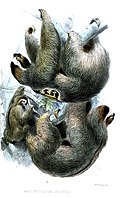磨齿兽科
| 磨齿兽科 | |
|---|---|

| |
| 哈伦氏副磨齿兽(P. harlani)全身骨骼化石,展示于美国德克萨斯大学奥斯汀分校德克萨斯州科学与自然历史博物馆 | |
| 科学分类 | |
| 界: | 动物界 Animalia |
| 门: | 脊索动物门 Chordata |
| 纲: | 哺乳纲 Mammalia |
| 目: | 披毛目 Pilosa |
| 亚目: | 食叶亚目 Folivora |
| 总科: | 磨齿兽总科 Mylodontoidea |
| 科: | †磨齿兽科 Mylodontidae Ameghino, 1889 |
| 子群 | |
| |
磨齿兽科(学名:Mylodontidae),又称磨齿懒科,是已灭绝的地懒,生存于2,300万至11,000年前的北美洲及南美洲[2]。磨齿兽科与同样已灭绝的陵角懒科,以及现存树栖性的二趾树懒科为近亲,三者均属于磨齿兽总科。磨齿兽科与陵角懒科之间的亲缘关系证据主要是来自种系发生学及形态学分析,甚至有部分较早期的研究会将陵角懒科置于磨齿兽科下[3]。而磨齿兽科与二趾树懒科之间的亲缘关系证据则仰赖粒线体DNA[4][5]及胶原蛋白胺基酸序列的分析研究[6]。后者分析显示二趾树懒科比起二趾树懒科,与磨齿兽科的亲缘关系更为接近。此外,同样仍未灭绝的树懒科(包含已知的4种三趾树懒)则是属于亲缘关系较远的大地懒总科[5][6]。
由于在洞穴中同时发现人类与地懒的遗骸,包括了数量不少的毛发、皮肤、粪便等亚化石,科学家最初认为这些早期的人类会建造畜栏来豢养这些地懒[7]。然而,放射性碳定年法分析显示人类及地懒生存于洞穴的时间并未有重叠[8]。磨齿兽科是目前已知确认具有皮内成骨的地懒,但仅有部分属具有此特征,其中就包括了磨齿兽属、副磨齿兽属及舌懒兽属,其他属则缺乏[9]。
系统发生树
[编辑]
本系统发生树系根据胶原蛋白及粒线体DNA序列分析[6]:
| 食叶亚目 Folivora |
| |||||||||||||||||||||||||||||||||||||||||||||||||||||||||||||||||||||||||||
参考文献
[编辑]- ^ Rincón, Ascanio D.; Solórzano, Andrés; McDonald, H. Gregory; Flores, Mónica Núñez. Baraguatherium takumara, Gen. et Sp. Nov., the Earliest Mylodontoid Sloth (Early Miocene) from Northern South America. Journal of Mammalian Evolution. 7 April 2016, 24 (2): 179–191. S2CID 23667414. doi:10.1007/s10914-016-9328-y.
- ^ http://paleodb.org/cgi-bin/bridge.pl?action=checkTaxonInfo&taxon_no=43629&is_real_user=1Mylodontidae: Paleobiology Database 互联网档案馆的存档,存档日期2012-10-13.
- ^ Gaudin, T. J. The Ear Region of Edentates and the Phylogeny of the Tardigrada (Mammalia, Xenarthra). Journal of Vertebrate Paleontology. 1995-09-14, 15 (3): 672–705. Bibcode:1995JVPal..15..672G. JSTOR 4523658. doi:10.1080/02724634.1995.10011255.
- ^ Hoss, Matthias; Dilling, Amrei; Currant, Andrew; Paabo, Svante. Molecular phylogeny of the extinct ground sloth Mylodon darwinii. Proceedings of the National Academy of Sciences. 9 Jan 1996, 93 (1): 181–185. Bibcode:1996PNAS...93..181H. PMC 40202
 . PMID 8552600. doi:10.1073/pnas.93.1.181
. PMID 8552600. doi:10.1073/pnas.93.1.181  .
.
- ^ 5.0 5.1 Delsuc, F.; Kuch, M.; Gibb, G. C.; Karpinski, E.; Hackenberger, D.; Szpak, P.; Martínez, J. G.; Mead, J. I.; McDonald, H. G.; MacPhee, R.D.E.; Billet, G.; Hautier, L.; Poinar, H. N. Ancient Mitogenomes Reveal the Evolutionary History and Biogeography of Sloths. Current Biology. 2019, 29 (12): 2031–2042.e6. PMID 31178321. doi:10.1016/j.cub.2019.05.043
 . hdl:11336/136908
. hdl:11336/136908  .
.
- ^ 6.0 6.1 6.2 Presslee, S.; Slater, G. J.; Pujos, F.; Forasiepi, A. M.; Fischer, R.; Molloy, K.; et al. Palaeoproteomics resolves sloth relationships (PDF). Nature Ecology & Evolution. 2019, 3 (7): 1121–1130 [18 September 2020]. Bibcode:2019NatEE...3.1121P. PMID 31171860. S2CID 174813630. doi:10.1038/s41559-019-0909-z. (原始内容存档 (PDF)于12 September 2020).
- ^ Woodward (1900)
- ^ Naish, Darren. Fossils explained 51: Sloths. Geology Today. 28 Nov 2005, 21 (6): 232–238 [2009-01-29]. S2CID 85808869. doi:10.1111/j.1365-2451.2005.00538.x.
- ^ McDonald, H. Gregory. An Overview of the Presence of Osteoderms in Sloths: Implications for Osteoderms as a Plesiomorphic Character of the Xenarthra. Journal of Mammalian Evolution. December 2018, 25 (4): 485–493. ISSN 1064-7554. S2CID 254697023. doi:10.1007/s10914-017-9415-8 (英语).
参考书目
[编辑]- Woodward, A.S. (1900): On some remains of Grypotherium (Neomylodon) listai and associated mammals from a cavern near Consuelo Cove, Last Hope Inlet. Proceedings of the Zoological Society of London, 1900(5): 64–79.
延伸阅读
[编辑]- Brandoni, Diego; Scillato Yané, Gustavo J.; Miño Boilini, Ángel R.; Favotti, Emmanuel. Los Tardigrada (Mammalia, Xenarthra) de Argentina: diversidad, evolución y biogeografía (PDF). Contribuciones del MACN. 2016, _: 263–274 [2018-10-08].
- Cuvier, G. (1796): Notice sur le squelette d'une très grande espèce de quadrupède inconnue jusqu'à présent, trouvé au Paraguay, et déposé au cabinet d'histoire naturelle de Madrid. Magasin encyopédique, ou Journal des Sciences, des Lettres et des Arts (1): 303–310; (2): 227–228.
- De Iuliis, G. & Cartelle, C. (1999): A new giant megatheriine ground sloth (Mammalia: Xenarthra: Megatheriidae) from the late Blancan to early Irvingtonian of Florida. Zool. J. Linn. Soc. 127(4): 495–515.
- Harrington, C.R. (1993): Yukon Beringia Interpretive Center - Jefferson's Ground Sloth. Retrieved 2008-JAN-24.
- Hogan, C.M. (2008): Cueva del Milodon, Megalithic Portal. Retrieved 2008-APR-13
- Kurtén, Björn and Anderson, Elaine (1980): Pleistocene Mammals of North America. Columbia University Press, New York. ISBN 0-231-03733-3
- McKenna, Malcolm C. & Bell, Susan K. (1997): Classification of Mammals Above the Species Level. Columbia University Press, New York. ISBN 0-231-11013-8
- Nowak, R.M. (1999): Walker's Mammals of the World (Vol. 2). Johns Hopkins University Press, London.
- White, J.L. (1993): Indicators of locomotor habits in Xenarthrans: Evidence for locomotor heterogeneity among fossil sloths. Journal of Vertebrate Paleontology, 13(2): 230–242.
- White, J.L.; MacPhee, R.D.E. The sloths of the West Indies: a systematic and phylogenetic review. Woods, C.A.; Sergile, F.E. (编). Biogeography of the West Indies: Patterns and Perspectives. Boca Raton, London, New York, and Washington, D.C.: CRC Press. 2001: 201–235. ISBN 978-0-8493-2001-9. doi:10.1201/9781420039481-14.
外部链接
[编辑]- Sloth World: An Online Sloth Bibliography
- Picture and information about a ground sloth skeleton on display at the University of Georgia's Science Library
- Academy of Natural Sciences ground sloth page
- Illinois State Museum ground sloth page
- Ground sloths at La Brea
- Eremotherium in Florida
- Have some ground sloths survived in Argentina?
- Ground sloths in general
- Western Center for Archaeology and Paleontology Hemet, CA
|





